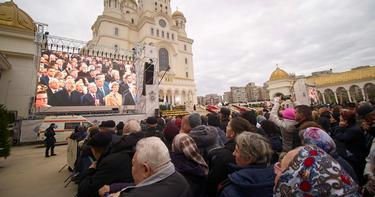Romania Unveils the World's Largest Orthodox Church
- okolobicynthia
- 5 days ago
- 2 min read

After fifteen years of relentless construction, Romania has officially opened the doors to the world’s largest Orthodox church — the People’s Salvation Cathedral, standing tall in the heart of Bucharest. Towering over the city’s skyline, the cathedral is both a symbol of national pride and a lightning rod for controversy. While it represents the spiritual heartbeat of a nation with deep Orthodox Christian roots, its immense cost and grandiosity have stirred a national debate about priorities, faith, and the fine line between devotion and display.
A Dream 15 Years in the Making
The People’s Salvation Cathedral, known locally as Catedrala Mântuirii Neamului, was first envisioned more than a century ago, but its construction only began in 2010. Today, it finally stands complete — a monumental structure with a height of 135 meters (443 feet), surpassing every other Orthodox church in the world. The church can accommodate over 5,000 worshippers, adorned with golden domes, intricate mosaics, and one of the largest Orthodox icons ever created.

For the Romanian Orthodox Church, this cathedral is a triumph — a long-awaited realization of faith, unity, and national identity. It serves not only as a place of worship but also as a cultural and spiritual landmark meant to stand the test of time.
The Cost of Grandeur
However, the celebration has been met with widespread criticism. With over €600 million (about $650 million) reportedly spent on its construction, questions about financial transparency and national priorities have loomed large. Critics argue that in a country where poverty still affects many communities, the government’s contribution to such an extravagant religious project is deeply misplaced.
Romania, one of the European Union’s least wealthy member states, continues to face challenges such as low wages, poor healthcare systems, and infrastructural gaps. For many citizens, the cathedral’s golden domes now reflect not just divine glory — but economic inequality.
Faith, Identity, and Division

Supporters of the project see the cathedral as a symbol of resilience — a beacon of faith that endured decades of communist suppression under Nicolae Ceaușescu’s regime, when religion was marginalized. To them, the People’s Salvation Cathedral is a spiritual victory, a statement that Romanian Orthodoxy remains at the core of the nation’s identity.
Yet, for others, the opulence of the cathedral stands in contrast to the very humility that faith teaches. As one social critic put it, “Christ preached compassion for the poor, not marble for the mighty.”
A Reflection of Modern Romania
The opening of the world’s largest Orthodox church raises a profound question: What defines a nation’s greatness — its monuments or its morality?
In a country still navigating the balance between tradition and modern progress, the People’s Salvation Cathedral embodies both pride and paradox. It is a breathtaking achievement that showcases the power of faith — yet it also mirrors the social and economic disparities that continue to divide Romania.
Ultimately, the cathedral stands as more than just a building — it is a reflection of the nation’s soul, wrestling between its spiritual aspirations and material realities. Whether history remembers it as a triumph of belief or a symbol of excess remains to be seen.










Comments